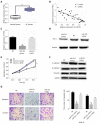MicroRNA-331 inhibits development of gastric cancer through targeting musashi1
- PMID: 31558975
- PMCID: PMC6755110
- DOI: 10.4251/wjgo.v11.i9.705
MicroRNA-331 inhibits development of gastric cancer through targeting musashi1
Abstract
Background: The molecular mechanisms involved in microRNAs (miRNAs) have been extensively investigated in gastric cancer (GC). However, how miR-331 regulates GC pathogenesis remains unknown.
Aim: To illuminate the effect of miR-331 on cell metastasis and tumor growth in GC.
Methods: The qRT-PCR, CCK8, Transwell, cell adhesion, Western blot, luciferase reporter and xenograft tumor formation assays were applied to explore the regulatory mechanism of miR-331 in GC.
Results: Downregulation of miR-331 associated with poor prognosis was detected in GC. Functionally, miR-331 suppressed cell proliferation, metastasis and tumor growth in GC. Further, miR-331 was verified to directly target musashi1 (MSI1). In addition, miR-331 inversely regulated MSI1 expression in GC tissues. Furthermore, upregulation of MSI1 weakened the inhibitory effect of miR-331 in GC.
Conclusion: miR-331 inhibited development of GC through targeting MSI1, which may be used as an indicator for the prediction and prognosis of GC.
Keywords: Gastric cancer; Metastasis; MicroRNA-331; Musashi1; Tumor growth.
Conflict of interest statement
Conflict-of-interest statement: The authors have no conflicts of interest to declare.
Figures





Similar articles
-
MicroRNA-31 inhibits tumor invasion and metastasis by targeting RhoA in human gastric cancer.Oncol Rep. 2017 Aug;38(2):1133-1139. doi: 10.3892/or.2017.5758. Epub 2017 Jun 27. Oncol Rep. 2017. PMID: 28656284
-
MiR-129-5p functions as a tumor suppressor in gastric cancer progression through targeting ADAM9.Biomed Pharmacother. 2018 Sep;105:420-427. doi: 10.1016/j.biopha.2018.05.105. Epub 2018 Jun 4. Biomed Pharmacother. 2018. PMID: 29879625
-
MicroRNA-4316 inhibits gastric cancer proliferation and migration via directly targeting VEGF-A.Cancer Cell Int. 2020 Feb 22;20:62. doi: 10.1186/s12935-020-1132-3. eCollection 2020. Cancer Cell Int. 2020. PMID: 32123520 Free PMC article.
-
MicroRNA-760 acts as a tumor suppressor in gastric cancer development via inhibiting G-protein-coupled receptor kinase interacting protein-1 transcription.World J Gastroenterol. 2019 Dec 7;25(45):6619-6633. doi: 10.3748/wjg.v25.i45.6619. World J Gastroenterol. 2019. PMID: 31832002 Free PMC article.
-
Intracellular functions of RNA-binding protein, Musashi1, in stem and cancer cells.Stem Cell Res Ther. 2020 May 24;11(1):193. doi: 10.1186/s13287-020-01703-w. Stem Cell Res Ther. 2020. PMID: 32448364 Free PMC article. Review.
Cited by
-
Exosomal Circ_FMN2 Derived from the Serum of Colorectal Cancer Patients Promotes Cancer Progression by miR-338-3p/MSI1 Axis.Appl Biochem Biotechnol. 2023 Dec;195(12):7322-7337. doi: 10.1007/s12010-023-04456-3. Epub 2023 Mar 30. Appl Biochem Biotechnol. 2023. PMID: 36995659
-
Musashi-1-A Stemness RBP for Cancer Therapy?Biology (Basel). 2021 May 5;10(5):407. doi: 10.3390/biology10050407. Biology (Basel). 2021. PMID: 34062997 Free PMC article. Review.
-
RNA-binding proteins in ovarian cancer: a novel avenue of their roles in diagnosis and treatment.J Transl Med. 2022 Jan 21;20(1):37. doi: 10.1186/s12967-022-03245-6. J Transl Med. 2022. PMID: 35062979 Free PMC article. Review.
-
Long non-coding RNA CCL2 promoted gastric cancer function via miR-128/ PARP2 signal pathway.Bioengineered. 2022 Jan;13(1):1602-1611. doi: 10.1080/21655979.2021.2020548. Bioengineered. 2022. Retraction in: Bioengineered. 2024 Dec;15(1):2299621. doi: 10.1080/21655979.2024.2299621. PMID: 35000531 Free PMC article. Retracted.
-
Potential targets and molecular mechanism of miR-331-3p in hepatocellular carcinoma identified by weighted gene coexpression network analysis.Biosci Rep. 2020 Jun 26;40(6):BSR20200124. doi: 10.1042/BSR20200124. Biosci Rep. 2020. PMID: 32537629 Free PMC article.
References
-
- Zong L, Abe M, Seto Y, Ji J. The challenge of screening for early gastric cancer in China. Lancet. 2016;388:2606. - PubMed
-
- Kishi K, Fujiwara Y, Yano M, Motoori M, Sugimura K, Takahashi H, Ohue M, Sakon M. Usefulness of diagnostic laparoscopy with 5-aminolevulinic acid (ALA)-mediated photodynamic diagnosis for the detection of peritoneal micrometastasis in advanced gastric cancer after chemotherapy. Surg Today. 2016;46:1427–1434. - PubMed
-
- Xu Z, Li C, Qu H, Li H, Gu Q, Xu J. MicroRNA-195 inhibits the proliferation and invasion of pancreatic cancer cells by targeting the fatty acid synthase/Wnt signaling pathway. Tumor Biol. 2017;39:101042831771132. - PubMed
LinkOut - more resources
Full Text Sources
Miscellaneous

